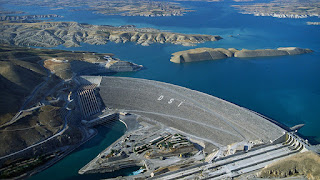The Atatürk Dam (Atatürk Barajı), originally the Karababa Dam, is a zoned rock-fill dam with a central core on the Euphrates River on the border of Adıyaman Province and Şanlıurfa Province in the Southeastern Anatolia Region of Turkey. Built both to generate electricity and to irrigate the plains in the region, it was renamed in honour of Mustafa Kemal Atatürk (1881–1938), the founder of the Turkish Republic.
The construction began in 1983 and was completed in 1990. The dam and the hydroelectric power plant, which went into service after the upfilling of the reservoir was completed in 1992, are operated by the State Hydraulic Works (DSİ). The reservoir created behind the dam, called Lake Atatürk Dam (Turkish: Atatürk Baraj Gölü), is the third largest in Turkey.
The dam is situated 23 km (14 mi) northwest of Bozova, Şanlıurfa Province, on state road D-875 from Bozova to Adıyaman. Centerpiece of the 22 dams on the Euphrates and the Tigris, which comprise the integrated, multi-sector, Southeastern Anatolia Project (Turkish: Güney Doğu Anadolu Projesi, known as GAP), it is one of the world's largest dams. The Atatürk Dam, one of the five operational dams on the Euphrates as of 2008, was preceded by Keban and Karakaya dams upstream and followed by Birecik and the Karkamış dams downstream. Two more dams on the river have been under construction.
The dam embankment is 169 m high (554 ft) and 1,820 m long (5,970 ft). The hydroelectric power plant (HEPP) has a total installed power capacity of 2,400 MW and generates 8,900 GW·h electricity annually. The total cost of the dam project was about US$1,250,000,000.
The dam was depicted on the reverse of the Turkish one-million-lira banknotes of 1995–2005 and of the 1 new lira banknote of 2005–2009. More details
The dam is situated 23 km (14 mi) northwest of Bozova, Şanlıurfa Province, on state road D-875 from Bozova to Adıyaman. Centerpiece of the 22 dams on the Euphrates and the Tigris, which comprise the integrated, multi-sector, Southeastern Anatolia Project (Turkish: Güney Doğu Anadolu Projesi, known as GAP), it is one of the world's largest dams. The Atatürk Dam, one of the five operational dams on the Euphrates as of 2008, was preceded by Keban and Karakaya dams upstream and followed by Birecik and the Karkamış dams downstream. Two more dams on the river have been under construction.
The dam embankment is 169 m high (554 ft) and 1,820 m long (5,970 ft). The hydroelectric power plant (HEPP) has a total installed power capacity of 2,400 MW and generates 8,900 GW·h electricity annually. The total cost of the dam project was about US$1,250,000,000.
The dam was depicted on the reverse of the Turkish one-million-lira banknotes of 1995–2005 and of the 1 new lira banknote of 2005–2009. More details
